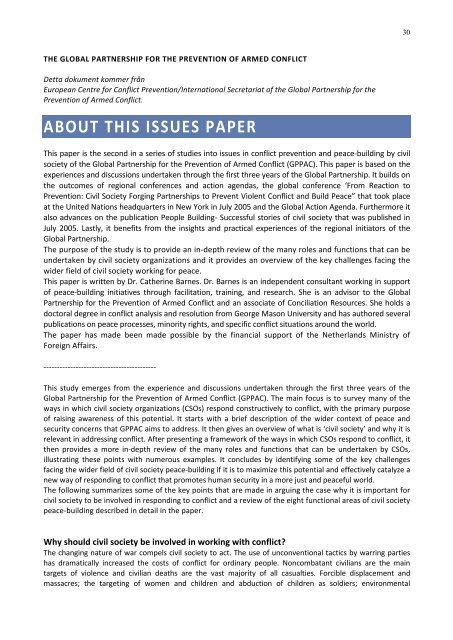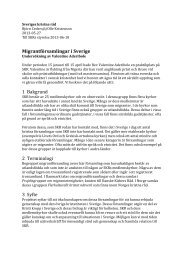Tyngdpunktsförskjutning rapport (PDF) - Sveriges kristna råd
Tyngdpunktsförskjutning rapport (PDF) - Sveriges kristna råd
Tyngdpunktsförskjutning rapport (PDF) - Sveriges kristna råd
Create successful ePaper yourself
Turn your PDF publications into a flip-book with our unique Google optimized e-Paper software.
THE GLOBAL PARTNERSHIP FOR THE PREVENTION OF ARMED CONFLICT<br />
Detta dokument kommer från<br />
European Centre for Conflict Prevention/International Secretariat of the Global Partnership for the<br />
Prevention of Armed Conflict.<br />
ABOUT THIS ISSUES PAPER<br />
This paper is the second in a series of studies into issues in conflict prevention and peace-‐building by civil<br />
society of the Global Partnership for the Prevention of Armed Conflict (GPPAC). This paper is based on the<br />
experiences and discussions undertaken through the first three years of the Global Partnership. It builds on<br />
the outcomes of regional conferences and action agendas, the global conference ‘From Reaction to<br />
Prevention: Civil Society Forging Partnerships to Prevent Violent Conflict and Build Peace” that took place<br />
at the United Nations headquarters in New York in July 2005 and the Global Action Agenda. Furthermore it<br />
also advances on the publication People Building-‐ Successful stories of civil society that was published in<br />
July 2005. Lastly, it benefits from the insights and practical experiences of the regional initiators of the<br />
Global Partnership.<br />
The purpose of the study is to provide an in-‐depth review of the many roles and functions that can be<br />
undertaken by civil society organizations and it provides an overview of the key challenges facing the<br />
wider field of civil society working for peace.<br />
This paper is written by Dr. Catherine Barnes. Dr. Barnes is an independent consultant working in support<br />
of peace-‐building initiatives through facilitation, training, and research. She is an advisor to the Global<br />
Partnership for the Prevention of Armed Conflict and an associate of Conciliation Resources. She holds a<br />
doctoral degree in conflict analysis and resolution from George Mason University and has authored several<br />
publications on peace processes, minority rights, and specific conflict situations around the world.<br />
The paper has made been made possible by the financial support of the Netherlands Ministry of<br />
Foreign Affairs.<br />
-‐-‐-‐-‐-‐-‐-‐-‐-‐-‐-‐-‐-‐-‐-‐-‐-‐-‐-‐-‐-‐-‐-‐-‐-‐-‐-‐-‐-‐-‐-‐-‐-‐-‐-‐-‐-‐-‐-‐-‐-‐-‐<br />
This study emerges from the experience and discussions undertaken through the first three years of the<br />
Global Partnership for the Prevention of Armed Conflict (GPPAC). The main focus is to survey many of the<br />
ways in which civil society organizations (CSOs) respond constructively to conflict, with the primary purpose<br />
of raising awareness of this potential. It starts with a brief description of the wider context of peace and<br />
security concerns that GPPAC aims to address. It then gives an overview of what is ‘civil society’ and why it is<br />
relevant in addressing conflict. After presenting a framework of the ways in which CSOs respond to conflict, it<br />
then provides a more in-‐depth review of the many roles and functions that can be undertaken by CSOs,<br />
illustrating these points with numerous examples. It concludes by identifying some of the key challenges<br />
facing the wider field of civil society peace-‐building if it is to maximize this potential and effectively catalyze a<br />
new way of responding to conflict that promotes human security in a more just and peaceful world.<br />
The following summarizes some of the key points that are made in arguing the case why it is important for<br />
civil society to be involved in responding to conflict and a review of the eight functional areas of civil society<br />
peace-‐building described in detail in the paper.<br />
Why should civil society be involved in working with conflict?<br />
The changing nature of war compels civil society to act. The use of unconventional tactics by warring parties<br />
has dramatically increased the costs of conflict for ordinary people. Noncombatant civilians are the main<br />
targets of violence and civilian deaths are the vast majority of all casualties. Forcible displacement and<br />
massacres; the targeting of women and children and abduction of children as soldiers; environmental<br />
30









